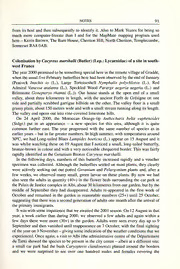
Colonisation by Cacyreus marshalli (Butler) (Lep.: Lycaenidae) of a site in southwest France PDF
Preview Colonisation by Cacyreus marshalli (Butler) (Lep.: Lycaenidae) of a site in southwest France
NOTES 91 from its host and then subsequently to identify it. Also to Mark Yeates for being so much more computer-literate than I and for the MapMate mapping program used here.-KeithBrown,TheBarnHouse,CheritonHill, NorthCheriton,Templecombe, SomersetBA8 OAB. ColonisationbyCacyreusmarshalli(Butler)(Lep.: Lycaenidae)ofasiteinsouth- west France Theyear2000promisedtobesomethingspecialhereintheremotevillageofGradde, whentheusualfiveFebruarybutterfliesherehadbeenobservedbytheendofJanuary (Peacock lnachis io (L.), Large Tortoiseshell Nymphalis polychloros (L.), Red Admiral Vanessa atalanta (L.), Speckled Wood Pararge aegeria aegeria (L.) and Brimstone Gonepteryx rhamni (L.)). Our house stands at the open end of a small valley, about three kilometres in length, with the ancient Foret de Gresigne on one side andpartially scrubbed garrigue hillside on the other. The valley floor is a small grassyplain, about 150metreswideandwithasmall streamrunning along itslength. Thevalley end opens out into vine-covered limestone hills. On 24 April 2000, the Moroccan Orange-tip Anthocharis belia euphenoides (Stdgr.) put in an appearance - a new species for this area, although it is quite common further east. The year progressed with the same number of species as in earlieryears-but in fargreaternumbers. Inhigh summer, with temperatures around 30SC, we had Long-tailed Blues Lampides boeticus (L.) appear on 15 August and it was whilst watching these on 19 August that I noticed a small, long-tailed butterfly, bronze-brown incolourand with avery noticeable chequeredborder. This was fairly rapidly identified as the Geranium Bronze Cacyreus marshalli. In the following days, numbers of this butterfly increased rapidly and a voucher specimen was collected. Although the butterflies settled on most plants, they clearly were actively seeking out our potted Geranium and Pelargonium plants and, after a few weeks, we observed many small, green larvae on these plants. By now we had also seen the adults in quantity (40+) in the flower beds surrounding the carpark at thePalaisdeJusticecomplexinAlbi,about30kilometresfromourgarden,butbythe middle of September they had disappeared. Adults re-appeared in the first week of October and remained in the garden in reasonable numbers (25+) until 25 October, suggestingthattherewas asecondgeneration ofadults onemonth afterthe arrival of theprimary immigrants. Itwaswithsomeimpatiencethatweawaitedthe2001 season. On 12Augustinthat year, a week earlier than during 2000, we observed a few adults and again within a few days there were more (30+) in the garden. Adults were seen every day up to 9 Septemberandthenvanisheduntilreappearanceon7 October, withthefinal sighting oftheyearon3November-givingsomeindicationoftheweatherconditionsthatwe experienced. Onceagain,avisittoAlbi (theadministrativecentreoftheDepartement duTarn) showedthe speciestobepresentinthecitycentre-albeitatadifferent site; a small car park had the bush Caryopteris clandonensis planted around the borders and we were surprised to see over one hundred males and females covering the 92 ENTOMOLOGIST'SRECORD,VOL. 114 25.iii.2002 flowers. Eventhe "passer-by" shoppers were stopping towatchthisphenomenon. At ourlocallargetownofGaillac (population 10,500) C. marshalliwas seenatagarden centre; however, it has travelled up the valley from Gradde (population 10) where it is establishedon wildGeranium spp. in ourmeadow aboutonekilometreupthelane fromthegarden. The species isnativetoextreme southernAfrica. Itwasrecordedfor the first time in Europe from Palma, Mallorca in November 1989 (Eitshberger & Stamer, 1990. Atalanta 21: 101-108) and was assumed to be an establishment resultingfrominitialintroduction. ItwasalsonotedonMallorca[asMajorca] thenext year, 1990 (Rayner, 1990. Ent. Rec. 102: 250). The following year it was reported from Belgium (Troukens, 1991. Phegea 19: 129-131). According to Leraut (1997. Liste Systematique et Synonymique des Lepidopteres de France, Belgique et Corse 2ndedition), afterhavingbeenfirst seenonMallorcaithas spreadtomainlandSpain and Italy; unpublished records to support this statement exists on the Internet as a photograph taken in Romeby R Mazzei during 1996, and anothertaken by A. Torry atGerona, Catalonia [Spain] in 1997. The year 1997 also saw the first"wildcaught" adult in Britain (at Lewes, East Sussex by John Holloway (Atropos number 4, 3-6) although it doubtless originated from an introduction of larvae on imported plants. Shaw (2001. Ent. Rec. 113: 262) considered that his observation of the species in Corsicaon4August2001 appearedtobethe firstrecordofthebutterflythere. White (1998. Ent. Rec. 110: 297) records C. marshalli as new to Portugal from the Algarve inMay 1998 andWhite(2000.Ent.Rec. 112: 179)notesthatthebutterflywaspresent on Granada as early as 1995. Foster (2000. Ent. Rec. 112: 271) records it as new to Lanzarote in 2000. The early spread in Europe is documented by Sarto I Monteys (1992. Res. Lep. 31: 24-34), whilstamore accessible summary (toBritishreaders) was givenby Honey (1993. Butt. Cons. News. 53: 18-19). Larsen (2000. Ent. Rec. 112:273-275) is of the opinion that the presence of the species in Spain and Southern France is the result of a "long range introduction", noting that it has even been found in Belgium and the UK, where it would probably be unable to survive on a permanent basis. Whilst migration from the extreme southern tipofAfricatoEurope is unlikely, theevidence fromGradde andelsewhere may suggest that current waves are the result ofphenomenal expansions ofthe new range of a species now established, and quite able to thrive on both wild and "domesticated" Pelargonium and Geranium species where available in conjunction with suitable climatic conditions. However,theyear2002willbeaseveretest.Forthefirsttimeintenyearsthewinter temperature here has been maintained at a level below zero for a continuous month (lowest -12°C), although by the end ofJanuary 2002 we had, again, already seen the "FebruaryFive".WehopethatthecyclewillbecompletedagaininAugust! -Michael Marney,Gradde, 81140Campagnac, France (E-mail: [email protected]). Gelechia cuneatella Douglas (Lep.: Gelechiidae), new to Lancashire On the night of29 July 2001, MrKevin McCabe came across agelechiidmoth with whichhe was unfamiliarinhis m.v. trap inFlixton, GreaterManchester(VC 59). He kindly passed it on to me for closer examination. Having set the moth, which was
